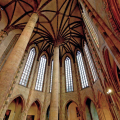Convent composed of a church, a cloister and a convent, a jewel of Languedoc Gothic art where Saint Thomas Aquinas rests
The convent of the Jacobins is without doubt the most striking building in Toulouse by its architecture. The contrast is striking between the exterior murality, the sobriety and the compact mass made of bricks and the interior once you pass the entrance gate. There opens an airy, airy church, an empty space where the colored light of the stained glass windows animates the whole.
The convent served both as the mother house of the Dominican order (known as the Jacobins) and as the seat of the city's first university. Its history is linked to the terrible crusade against the Cathars and the consequences of the defeat of the Count of Toulouse. The mendicant orders, including that of the Friars Preachers, were approved at the Lateran Council of 1215. The establishment of the monastery on this site began in 1229 with the construction of a first very modest convent. The transformation, as we see it today, took place during the 13th and 14th centuries. Devastated by the occupation of the Napoleonic armies, which established cavalry and artillery, the convent recovered its former splendor after long years of restoration carried out, since the intervention of Prosper Merimee, until 1974 and then renewed in 2015 for the celebration of the eight hundred years of the order.
A masterpiece of Southern Gothic. This style, specific to the Languedoc region, is characterized by a single nave (here divided into two, one to the south to accommodate the faithful, the other to the north reserved for the friars), without transept or ambulatory, a vault resting on ribbed crossings, a weight distributed on the load-bearing walls with open funeral chapels between the buttresses. There is no sculpted or painted decoration, no grandiose portal or soaring towards the sky. Nevertheless, the feeling of elevation is present thanks to the row of columns rising to 28 m high.
The relics of St. Thomas Aquinas have rested under the altar since 1369. Mass on January 28 each year.
The "Jacobin Palm" is the name given to the central column that supports the choir traffic circle. Twenty-two two-colored ribs give it the poetic image of an exotic tree.
The cloister (1310-1340) gives access to the chapter house and to the chapel of Saint-Antonin, a former funeral chapel. Paintings on the wall and on the vault. Many concerts.
The refectory, an immense vessel covered by a framework supported by diaphragm arches, was once used by the monks to eat their only meal of the day. Now, it regularly hosts art exhibitions (often contemporary, see the Spring of September).
Did you know? This review was written by our professional authors.
The strengths of this establishment:
Members' reviews on JACOBIN CONVENT
The ratings and reviews below reflect the subjective opinions of members and not the opinion of The Little Witty.






L'accès au cloître est payant mais en vaut le détour avec une magnifique vue du clocher.
La visite guidée par Charlotte fut merveilleuse, vivante et très intéressante. Une guide à la hauteur et passionnée.
Le seul bémol fut l'accueil peu chaleureux et presque agressif de la dame aigri.
Vite oublié grâce à cet édifice somptueux !